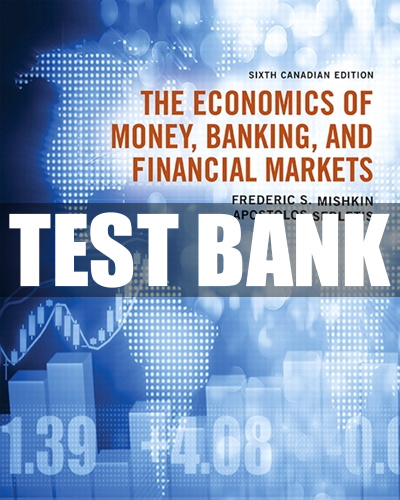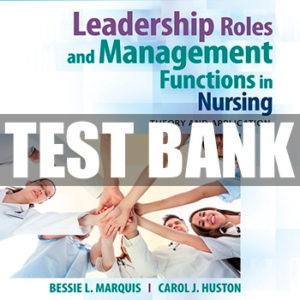The Economics Of Money, Banking And Financial Markets, Sixth Canadian Edition Test Bank
$15
Description
The Economics Of Money, Banking And Financial Markets, Sixth Canadian Edition Test Bank
Contents
Chapter 1 An Overview of Finance 1
Chapter 2 Financial Markets 11
Chapter 3 Intermediaries 21
Chapter 4 The Structure of Interest Rates 32
Chapter 5 The Federal Reserve and the Money Supply 42
Chapter 6 The Time Value of Money 52
Chapter 7 Risk and Return 63
Chapter 8 Asset Valuation: Bonds 74
Chapter 9 Asset Valuation: Stock and Market Efficiency 84
Chapter 10 Capital Budgeting: Introduction and Techniques 94
Chapter 11 Estimating Cash Flows and Refinements to Capital Budgeting 105
Chapter 12 The Cost of Capital 116
Chapter 13 The Theory of Capital Structure 127
Chapter 14 Financial Statement and Ratio Analysis 137
Chapter 15 Financial Planning, Forecasting, and Cash Budgets 147
Chapter 16 The Management of Working Capital
157
Chapter 17 International Finance 166
Chapter 18 Applying Financial Concepts: A Case Study 176
Answer Section 186
1
CHAPTER 1
An Overview of Finance
Multiple Choice
1) Which of the following topics are included in a broad-based study of finance?
a. Investments
b. Corporate finance
c. Employment policies for brokerage firms
d. All of the above.
e. Answers (a) and (b) only.
2) Which of the following statements is not true with respect to the study of finance?
a. Finance is the study of managing money.
b. At the most basic level, finance involves determining where to get money and what to
do with it.
c. An artist pricing his art is using financial principles.
d. Few positions today require an understanding of the basic financial principles.
e. All of the above statements are true with respect to the study of finance.
3) A strong background in finance will be most useful in enabling an individual investor to
a. determine the amount to save annually to retire comfortably.
b. understand columns about environmental events that appear in the newspaper.
c. use proper language when writing memoranda about investment opportunities for
prospective clients.
d. develop successful techniques to market securities.
e. determine the optimal number of employees in an organization.
4) A college-level course in finance may be best described as
a. a study of how to manage money.
b. an academic discipline that teaches one all the ways to become wealthy.
c. a course that is useful to business majors, but provides little value to art or history
majors.
d. a subject that benefits only those who aspire to work in large corporations.
e. one that qualifies students to work in banks and brokerage firms, but not for
manufacturers.
5) Securities that mature in more than one year are traded in
a. money markets.
b. capital markets.
c. derivatives markets.
d. swap markets.
e. treasury markets.
6) Business managers deal with ________________, who help take securities public.
a. investment banks
b. the Federal Reserve
c. commercial banks
d. thrift institutions
e. finance companies
7) Which of the following functions are directly or indirectly performed by securities markets?
a. Derive prices for securities traded in a market.
b. Determine interest rates.
c. Provide credit to those who wish to borrow.
d. Channel funds to all borrowers who desire loans.
e. All of the above are functions that are directly or indirectly performed by securities
markets.
8) Which of the following is not a financial institution?
a. Federal Reserve banks
b. Thrift institutions
c. Investment banks
d. Finance companies
e. The United States Treasury Department
9) A portfolio may be defined as
a. several hundred shares of stock in a single firm.
b. a group of different securities.
c. a list of potential clients to be contacted by a stockbroker.
d. a group of banks located in a large city.
e. a “shell corporation” set-up by rich investors to avoid capital gains taxes.
An Overview of Finance 3
10) Wise investors hold ____________ in their portfolios to ___________ their risk.
a. few securities; reduce
b. a variety of securities; increase
c. few securities; increase
d. a variety of securities; reduce
e. None of the above.
11) Which of the following statements best describes mutual funds?
a. They appeal only to wealthy investors.
b. They provide good investment returns, but insufficient diversification.
c. They enable many investors with limited funds to buy a diversified portfolio of
securities.
d. They enable investors to buy many shares of stock in a single firm at a lower cost than
using a stockbroker.
e. They are illegal in the United States, but popular in Europe.
12) The relationship between risk and return in finance can be best described by which of the
following statements?
a. The riskier the security, the greater the return the investors expect from it.
b. The riskier the security, the more the government regulates the firms selling it.
c. Riskier securities provide higher commissions to brokers who sell them.
d. Riskier securities are more likely to be returned to brokers by unhappy buyers.
e. The riskier the security, the lower the return expected from it.
13) Ways in which financial managers can raise funds to pay for expansion include
a. selling the firm to a larger one with the financial resources to fund the expansion.
b. selling stock to investors.
c. borrowing from lenders.
d. All of the above.
e. (b) and (c) only.
14) Financial ratios and common-size financial statements help managers to accomplish all of
the following except
a. identify areas that require remedial action.
b. identify a firm’s strengths and weaknesses.
c. analyze a firm’s performance.
d. determine if their firm is complying with environmental regulations.
e. forecast a company’s future strengths and weaknesses.
4 Chapter 1
15) In a broad sense, every business asset is ultimately owned by
a. individuals.
b. the federal government.
c. foreign governments.
d. trust funds.
e. None of the above.
16) Which of the following does not provide funds to the economy?
a. Individuals
b. Businesses
c. Government
d. Pension fund
e. All of the above provide funds to the economy.
17) In a typical life cycle, people spend more than their current income
a. just before retirement.
b. during their early employment years.
c. in their early 40s.
d. while working in their mid-50s.
e. within a short time after they die.
18) The primary role of a financial system is to
a. channel funds from savers to borrowers who need funds for investment projects.
b. regulate the banking system.
c. provide employees in financial institutions with a code of ethics.
d. enable financial managers to evaluate investment projects with a system that always
selects the correct opportunity for their firm.
e. make savvy investors rich.
19) Managers of corporations should act in ways that
a. maximize profits.
b. maximize shareholder wealth.
c. benefit society, even if shareholders do not materially prosper.
d. increase sales volume.
e. produce the most technologically advanced products.
An Overview of Finance 5
20) Which of the following is not a problem with profit maximization?
a. It can result in short-sighted management decisions.
b. It incorporates risk but ignores return.
c. It ignores the timing of cash flows.
d. It aims to maximize profits in every period and this is not what shareholders may want
managers to do.
e. All of the above are problems with profit maximization.
21) Under shareholder wealth maximization, the directive to managers is to ____________ the
firm’s cash flows while _____________ risk.
a. decrease; maximizing
b. decrease; minimizing
c. increase; maximizing
d. increase; minimizing
e. None of the above.
22) An accountant reports a firm’s financial condition at a point in time on which financial
statement?
a. Balance sheet
b. Income statement
c. Cash flow statement
d. Sources and uses statement
e. Conditional statement
23) Total shareholder wealth can be calculated by
a. dividing the value of the firm’s assets by the number of outstanding shares.
b. finding earnings per share by dividing the profits earned over the last year by the
number of outstanding shares.
c. multiplying the number of shares outstanding by the market price per share.
d. multiplying the number of shares outstanding by the book value per share.
e. subtracting the book value of bonds from the book value of assets.
24) Which of the following factors is most likely to decrease a firm’s stock price?
a. A stock-split announcement.
b. An increase in expected cash flows from a firm’s assets.
c. A delay in the timing of a firm’s cash receipts from a project relative to earlier
expectations.
d. Rumors about the imminent takeover of a firm.
e. News of a technological breakthrough that will improve a firm’s prospects.
6 Chapter 1
25) An agency cost is any benefit a manager derives from a company that _____________
shareholder wealth and _____________ of the manager’s agreed-upon compensation.
a. increases; is part of
b. increases; is not part of
c. does not increase; is part of
d. does not increase; is not part of
e. None of the above.
26) Agency problems are most likely associated with which situation?
a. Owners of many corporations do not manage them on a day-to-day basis.
b. Once a broker earns a commission for selling shares, a disgruntled investor cannot get a
refund.
c. Corporate managers are poorly paid and seek “fairness” by using company autos and
office telephones to make personal calls.
d. A decline in employee loyalty resulting from recent corporate “downsizing” strategies.
e. Accountants hired for short-term assignments from temp agencies often make costly
mistakes.
27) The only way that sellers of risky securities can entice investors to _________ these
securities is to offer a ________ interest rate.
a. buy; lower
b. buy; higher
c. sell; higher
d. sell; constant
e. buy; constant
28) The real rate of interest may be defined as
a. the interest rate on any loan used to finance a real estate purchase.
b. any interest rate that is reported the moment it changes.
c. the additional purchasing power a lender requires for deferring consumption in an
earlier period.
d. the rate of interest that includes some compensation for the loss of purchasing power
resulting from unexpected inflation.
e. the rate of interest reported in a newspaper.
An Overview of Finance 7
29) Which of the following is not a finance maxim mentioned in your text?
a. Investors will not delay consumption unless they expect to get something extra in
return, nor will they incur risk without being compensated for that risk.
b. Good deals go to the investor who is able to recognize them and reacts first.
c. Cash flows determine value.
d. A dollar received in the future is worth more than a dollar received today.
e. Asymmetric information is the difference in the information set held by different
participants in the financial marketplace; these differences must be addressed by
business participants.
30) Which of the following is a true statement?
a. The required return for a security is always equal to its actual return.
b. The required return for a security is always equal to its predicted return.
c. The required return from securities usually fluctuates with changes in risk.
d. The risk-return line usually slopes downward.
e. All investors are compensated for the risk they bear from their portfolios.
31) Which of the following policies or institutional changes would make a securities market
more efficient?
a. Imposing taxes on security returns.
b. Requiring investors to hold securities longer to reduce market volatility.
c. Improving the timeliness and accuracy of information flows from firms and securities
markets to investors.
d. Requiring firms to issue more stock to reduce volatility.
e. Electing a pro-business Republican president.
32) $100 today is worth
a. the same as $100 to be received in one year since the inflation rate has been low
recently and funds received in the near future should have the same purchasing power
that they have today.
b. less than $100 to be received in one year since many people will spend money foolishly
today and will become more careful in their spending habits as they mature.
c. more than $100 to be received in one year since you can invest the money received
today for this period, leaving you with more than $100 in the future.
d. the same as a future receipt of $100 since the physical characteristics of U.S. currency
are unchanged for long periods of time.
e. less than $100 received by someone ten years ago since many products have been
improved over this time period.
8 Chapter 1
33) Mario Inc. just invested in a project valued at $500 million. Just prior to the investment,
Mario stock was trading at $33.50 per share and earnings per share (EPS) were $4.20.
Analysts predict that EPS would increase to $4.60 because of the project. The change in the
expected return on Mario stock is
a. 12.54%.
b. 1.19%.
c. 11.91%.
d. 13.73%.
e. None of the above.
34) Opportunity costs may be defined as
a. the highest return an investor could have earned from investing in the next-best
alternative.
b. an investment in something, like higher education, that prepares you to take advantage
of future opportunities.
c. the costs incurred by a business that permit them greater flexibility to adapt to market
changes.
d. the labor costs borne by a firm while waiting for cash flows to be realized from its
sales.
e. the costs borne by well-informed investors to help them select undervalued stocks.
35) A manager is considering an investment opportunity. Which of the following factors
should not be taken into consideration to properly evaluate the proposal?
a. The time value of money when considering the project’s future cash flows.
b. The opportunity cost of the value of the initial investment.
c. The riskiness of the project.
d. The probability that the manager will benefit personally from the project.
e. The projected returns from other investment proposals.
36) The main difference between cash flows and accounting profits is
a. that accounting profits are not reported in monetary terms.
b. that accountants report profits when they are received, not earned.
c. not meaningful – the terms both refer to the same concept.
d. a result of the widespread use of accrual accounting.
e. meaningful only under generally accepted accounting principles (GAAP) in the United
States, but not for other countries.
An Overview of Finance 9
37) Which of the following is not an example of a situation in which asymmetric information is
present?
a. A business owner applies for a loan at a bank and must disclose information about the
expected earnings from the project to be funded by the loan.
b. You consider what topics to study for a marketing quiz next week.
c. Your friend attempts to purchase an auto insurance contract.
d. You purchase one pound of ground beef at the local supermarket.
e. None of the above.
38) Bondholders
a. have no legal rights that are recognized by borrowers.
b. directly elect the firm’s directors.
c. know managers will act in their interest because of incentives related to the manager’s
compensation.
d. must rely on legal means to protect their rights.
e. always lose the total value of their investment if the firm liquidates its assets.
39) Which of the following statements is true?
a. The presence of asymmetric information in financial markets increases the likelihood
that these markets are efficient.
b. Accounting profits are always more important to shareholders than cash flows.
c. Investors should not be compensated with a higher return for owning risky securities
since they should know better than to buy stock in a firm that has uncertain prospects.
d. The study of finance only benefits students who aspire to careers in business.
e. Managers should choose investment projects that maximize shareholder wealth.
40) Which of the following is the best way to prevent an agency problem between shareholders
and managers?
a. Pay managers a bonus if their division exceeds its quarterly sales target.
b. Reward managers if they keep costs below the budgeted amount.
c. Compensate managers to a significant degree with shares of stock in their firm.
d. Pay managers a bonus if their division exceeds its targeted market share.
e. Maintain a proportional relationship between a manager’s bonus and the number of
employees in the firm.
1 0 Chapter 1
Essay
1) Briefly describe the life-cycle spending of an individual. Provide brief examples of the financial
intermediaries involved in each stage of the life-cycle.
2) What are the five key concepts in finance?
3) Shareholder wealth maximization suggests that managers may be willing to take wealth away
from a firm’s bondholders and give it to the stockholders. State why this is true and provide an
example of how managers might attempt to accomplish this. What prevents managers from
behaving in this manner?
4) The line relating risk to return is upward sloping. Why? What would happen if the risk-return
tradeoff was not positive?
5) In recent years, many dot.com companies failed because they lacked the cash flows necessary
to support their operations. Often, these companies measured their success and growth by the
number of Web site “hits,” and many of these firms were ultimately considered to be
overvalued. Furthermore, it was relatively easy for these firms to obtain cheap financing from
venture capitalists. Relate these occurrences to the finance concepts that cash flows determine
value and the risk-return tradeoff. Would it be more expensive for new dot.com startups to
borrow funds now that many earlier startups have failed?
You must be logged in to post a review.





Reviews
There are no reviews yet.